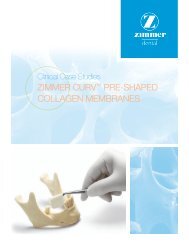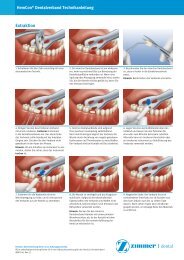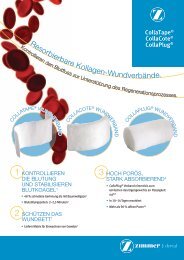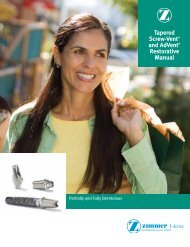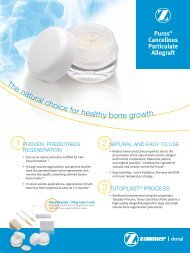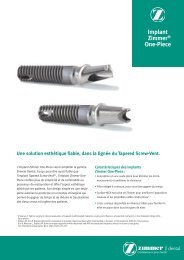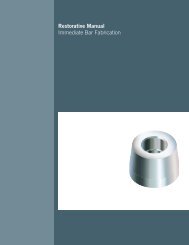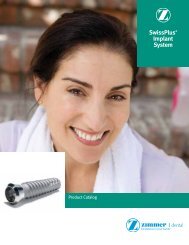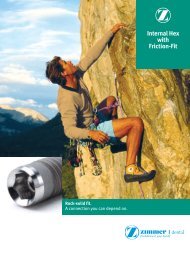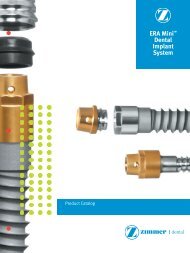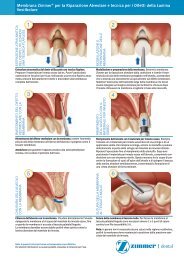Immediate Implant Placement and Provisionalization - Zimmer Dental
Immediate Implant Placement and Provisionalization - Zimmer Dental
Immediate Implant Placement and Provisionalization - Zimmer Dental
You also want an ePaper? Increase the reach of your titles
YUMPU automatically turns print PDFs into web optimized ePapers that Google loves.
CE 1Figure 1—Diagnostic wax-up.Figure 2—TempStent surgical stent/provisionalization system.Figure 3—Analogs set into maxillary study cast.tapered, which provides the best chance forobliterations of the coronal portion of thesocket. It also mimics the natural convergence,which occurs in the natural tooth system, tothe apical portion of the socket. The implantsurface should be roughened with surfaceenhancements to promote a rapid integration<strong>and</strong> to enhance the initial stabilization of thefixture. The polished implant collar should be≤ 1 mm in height, which allows the final positionof the implant collar to be at a positionthat is superior to the crest of the bone. Thisposition allows soft tissue attachment in theregion of the collar. The roughened implantsurface at the first thread, or at its smoothtransfer from the polished collar to the roughenedsurface, allows bone attachment. Placingthe implant in this fashion eliminates the“dieback” phenomenon.Figure 4—Preparation of stock abutments on theTempStent model.Grafting MaterialAccording to the author’s clinical experience,autogenous bone is the best grafting materialavailable. It is osetoconductive, osteoinductive,<strong>and</strong> osteogenic. 16-19 However, one of thedrawbacks of autogenous bone is that a secondsurgical site is necessary to harvest the bonetissue. Many of these techniques require complicatedsurgical procurement <strong>and</strong> add significantsurgical time <strong>and</strong> morbidity. Other optionsinclude the use of allogenic, alloplastic, <strong>and</strong>xenographic 20,21 grafting materials, either with orwithout the use of various regenerative barriers.All have been well documented. 22 The nonautogenousgrafting material should be biocompatiblewith the host tissue, osteoconductive, 23-27osteoinductive, 28,29 <strong>and</strong> osteotrophic. 30,31 Not allallogenic or alloplastic grafting materials possessthese important qualities. Some must rely on avehicle to reconstitute their granular form. Theauthor 32-34 <strong>and</strong> others 35,36 have observed thatplatelet-rich plasma (PRP) has enhanced theosteoconductive, <strong>and</strong> possibly the osteoinductive,properties of various allogenic, alloplastic,<strong>and</strong> xenographic materials.Platelet-Rich PlasmaThe ideal autogenous vehicle for reconstitutingthe alloplastic, allogenic, or xenographic substrateis PRP (autologous platelet gel), 37,38 whichis developed from autologous blood with a cellseparator. The cell separator used herein followsa dual spin cycle <strong>and</strong> is complete in 12minutes (Smart PreP ,c ). Centrification of 55mL of whole blood results in 10 mL of PRPcHarvest Technologies Corporation, Plymouth, MA 02360;(508) 732-75004 Compendium / February 2003 Vol. 24, No. 2



